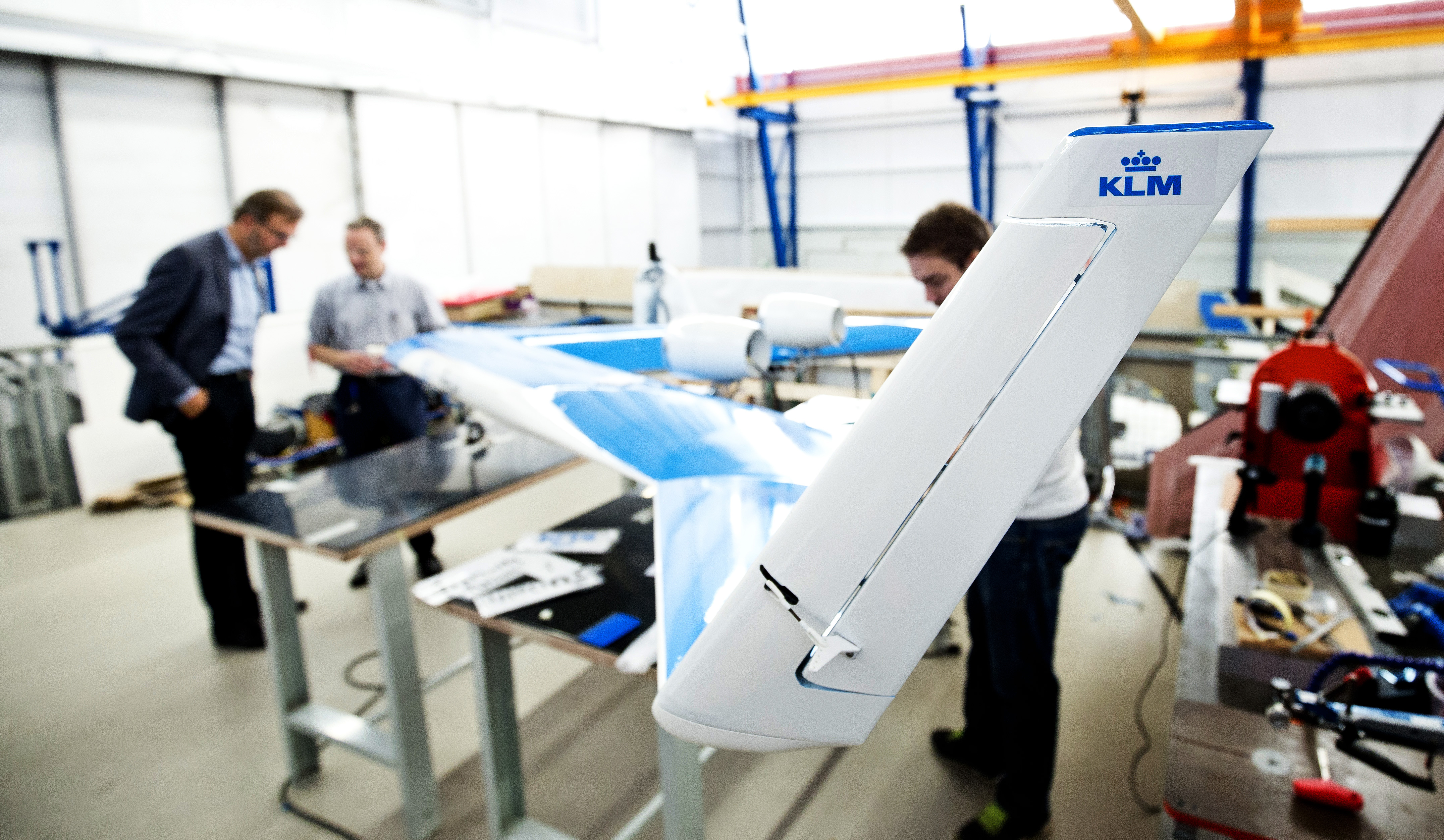TU Delft presents scale model and cabin for energy-efficient Flying-V
At the KLM Experience Days, from 3-13 October 2019, TU Delft will be presenting part of the cabin and a flying scale model of the revolutionary, energy-efficient Flying-V. This V-shaped aircraft design is expected to consume 20% less energy thanks to its improved aerodynamics and lighter weight. The more than 3 metres wide scale model will take to the air later this year. The cabin features an experimental design, with four types of seats, including group seating and foldaway beds in economy class. The TU Delft Flying-V – a collaboration with KLM – is one of the routes that TU Delft is exploring in its efforts to make aviation more sustainable. Dean Henri Werij: “Ultimately, we have to fly solely on sustainable energy. CO2-neutral. I am confident that we will be able to do that.”
Full-length sleeping in economy class
Professor Peter Vink and industrial design engineer Thomas Rotte developed the designs for the new oval-shaped cabin, combining knowledge of lightweight design techniques with passenger comfort. Vink: “The Flying-V can be arranged to suit customer needs, either in the traditional way, as in the current Airbus A350, or radically differently. The aim of our interior concept for the Flying-V is to improve the passenger experience at a lower weight and with passenger numbers comparable to the current Airbus A350. Developed together with 80 students of Industrial Design Engineering, the concept includes four types of seating: beds, lounge areas, group seating and individual seats. We take advantage of the oval shape by creating beds and positioning the seats in the flight direction, to avoid passengers sitting shoulder to shoulder.” At the KLM Experience Days and during Dutch Design Week later in October, visitors will have an opportunity to see a full-size section of the Flying-V cabin and try out some of the seating. A patent on the design of the beds has already been applied for.
Flying scale model
The design for the Flying-V was presented at the IATA conference in Seoul last June. Over the summer months, a team of engineers, technicians, students and researchers have built a flying scale model measuring 3.06 m in width and 2.76 m in length. The model – a sizeable drone – is intended for scaled flight testing. During the test flight, the stability of the aircraft will be measured and tests conducted to determine the best angle for take-off and landing. Building a scale model of this kind is far from easy: the model needs to include all of the systems to fly and control the plane as well as the sensors to measure and communicate aircraft behaviour. Project leader Roelof Vos: “This has been an extraordinary learning experience for the engineers and students working on the model in our lab.” A question that people often ask about the Flying-V is whether the extra G forces created will make it uncomfortable for passengers. Project leader Roelof Vos: “Research by Airbus has now shown that passengers are not affected by this, because they are sitting at the front of the wing. But this also demonstrates that such a radically different aircraft design requires just about everything to be retested and measured.” Vos hopes to be able to conduct the first flight tests later this year. “These are exciting times. We won’t know how the aircraft reacts until we fly it.”
Flying on sustainable energy
On 4 October, some 40 experts from universities, knowledge institutions and business met to discuss the Flying-V research agenda. Vos: “A lot of further research is required, covering such areas as flight performance, noise and how to accommodate the Flying-V in existing airports.”The Flying-V is one of TU Delft's lines of research into making aviation more sustainable. Dean Henri Werij: "Ultimately, we have to fly solely on sustainable energy. CO2-neutral. If the aircraft of the future continue to emit CO2 because we fly on for example, synthetic kerosene, we will then have to find a way to extract the same amount of CO2 from the atmosphere to produce those fuels. At Delft University of Technology, we are investigating how we are going to achieve this. For example, we are investigating new forms of propulsion, such as electric and electric hybrid, the climate impact of aviation and air traffic operations, such as airports.”
KLM100
KLM is a partner in the Flying-V project. Werij: “It’s fantastic to be able to work with KLM on sustainable aviation, especially in this special year in which KLM celebrates their centenary jubilee. On behalf of all of us at TU Delft: congratulations!”
Want to see the Flying-V?
- Background article in Trouw newspaper, 28 September 2019
- View the animations on the Flying-V site
- TV documentary on KLM centenary (100 jaar KLM), RTL-Z 20.30 on 7 October
- TV climate special (Staat van het Klimaat), 24 October NPO1
- Dutch Design Weeks in Eindhoven: 19 – 27 October
More information:
On the aircraft design and scale model (Faculty of Aerospace Engineering):
Roelof Vos, researcher in Flight Performance and Propulsion: +31 (0)15 278 5643
Ineke Boneschansker, public relations office: +31 (0)15 278 5361
On the design of the cabin and passenger experience (Faculty of Industrial Design Engineering):
Thomas Rotte, industrial design engineer: by phone through department secretariat: +31 (0)15 278 2625
Marc de Kool, public relations office: +31 (0)15 278 3723
For background information, animations and – high-res – image materials please visit www.tudelft.nl/flying-v.


